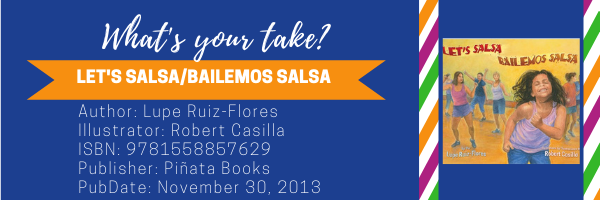By María V. Acevedo-Aquino and Myriam Jimena Guerra, Texas A&M University-San Antonio, San Antonio, TX
Myriam Jimena and María have three more bilingual books authored and/or illustrated by Lupe Ruiz-Flores and Carolyn Dee Flores. From now on, readers will notice that each book depicts brave female characters ready to advocate for themselves and others.
MYRIAM: This book addresses family and fitness in a fun way. The story narrates how Estela accompanies her mother to the community recreation center, where she discovers a completely different meaning for a very familiar word, which is salsa. Let’s listen to Estela’s own words: “Salsa? That’s what it’s called? I thought salsa was to eat with chips!” Well, not precisely. The salsa in this story refers to the music that is used for exercising. Estela enjoys dancing at the rhythm of salsa along with her new friends. Until one day, kids are banned from joining the adults in the class. Instead of complying, Estela engages in activism, after learning in school about how women fought to obtain voting rights, and initiates a petition for the kids to be allowed to participate in the fitness classes.
This book counters the narrative that LatinX girls are passive and obedient. Instead it displays a courageous and brave Estela with a resolve attitude, who shows agency by learning about healthy choices. She showed young children to be conscious of their own reality, overcome challenges, and encourage them to intervene when encountering a non- fair situation.
MARÍA: I agree with you Jimena. This book can encourage several important conversations. For example, the playful approach to language can encourage explorations of words with multiple meanings, as well as linguistic variations in Spanish speaking communities. People have asked me either if Spanish is the same in all countries or if it is so different that Spanish speakers from Puerto Rico and Mexico or Colombia will not be able to understand each other.
I’m also excited about Estela’s willingness to advocate for herself. The story depicts a clever young girl who is making connections between the school curriculum and her life, by creating a petition for a salsa instructor for the youth. (A young Latina navigating and negotiating school, home, and community in meaningful ways!) She received support from her parents, classmates, community members, even from the mayor! This journey, although quickly described in the book, can lead to inquiries around children engaging in self-advocacy or actions to improve their communities. I like that the petition encouraged the creation of a new space, rather than just letting children join the adult class, pretty realistic.
MYRIAM: I easily relate to this story, because I am from Colombia, a tropical country, where we have salsa for cooking, but where salsa music and dancing salsa is revered too. Particularly in Cali, the city where I was born and raised, girls learn how to dance at a young age. They are taught how to dance by their mothers, older sisters, aunties, cousins, and friends. A good dancer is highly appreciated, and once you learn how to dance, you are allowed to participate in family social events.
This book opens the dialogue about the diversity present in the LatinX community within the United States and Latin American countries, which is not often visible or acknowledged in children’s literature. This great diversity is evident when looking at individuals from different regions, which have their own cultural expressions such as music, art, literature, folks, language variations, and traditions.
MARÍA: What a powerful point Jimena! In this story, music and dance is explored as a sport or a leisure activity with individual benefits, like losing weight or feeling more energized. However, your family connection positions salsa and music as part of a cultural socialization process, which is exactly how I experienced music growing up in Puerto Rico. Dancing was a means to build relationships with family members, to learn about your culture, and to belong. I think that dancing, especially salsa, was (and is) viewed with a special pride. For example, I have heard many times: anybody can dance merengue, but few can dance salsa. This conversation reminds me about Richard Ruiz’ distinction between language as part of an individual’s identity, and language as a tool. I think this book, and Lupita’s First Dance/El primer baile de Lupita (2012), which we will review next week can support readers exploring their experiences with music, and how these impact who they are individually and as part of different communities.
Title: Let’s Salsa/Bailemos salsa
Author: Lupe Ruiz-Flores
Illustrator: Robert Casilla
Translator: Natalia Rosales-Yeomans
ISBN: 978-1-55885-762-9
Publisher: Piñata Books
PubDate: November 30, 2013
Throughout September 2020, Myriam Jimena and María explore the contributions of two authors of children’s literature living in San Antonio, TX: Lupe Ruiz-Flores and Carolyn Dee Flores (mother and daughter). Check back each Wednesday to follow the conversation!

